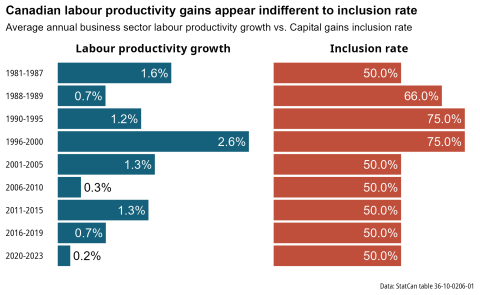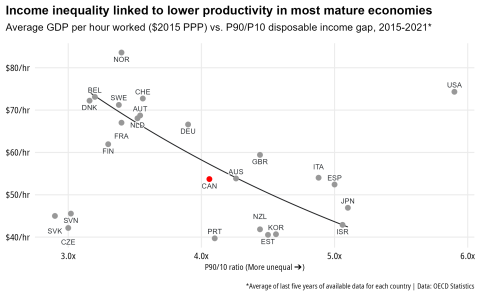Summary
Canada’s tax system is well known for its deeply unfair preferential treatment of income from property and investment compared to income from wages. One way this plays out is the treatment of capital gains, profit made by selling capital assets that have increased in value, like business shares or investment properties.
Until recently, only half of such income was included as taxable income. In the most recent 2024 Federal Budget, an increase of the inclusion rate from one-half to two-thirds for corporations, trusts, and gains over $250,000 for individuals was announced – a modest but necessary step in making Canada’s tax system more fair.
Against the backdrop of a Bank of Canada declared productivity emergency, economists, lobbyists, and corporate executives alike have decried the proposed change under the assertion that any tax increase on capital income will inevitably harm productivity by discouraging investment and innovation. These claims have been made without any evidence to support them, and yet, they have received broad media coverage. However, it is foolish to take the old trope that taxation hurts productivity as an article of faith when that data tells a different story.
Report
Canadian data shows no connection between capital gains taxation and productivity growth
What can be learned about the relationship between productivity and the capital gains inclusion rate by examining Canadian historical data?
In short, they have little to do with each other. The chart below compares annual average labour productivity growth to the capital gains tax inclusion rate over the last four decades. Two trends are clear in the productivity data: a cyclical component and a long downward arc, neither of which are obviously impacted by capital gains inclusion rate.
In the short term, productivity growth is closely connected to the boom-bust cycle of capitalist economies. During a boom phase, productivity gains are more rapid. Canada's best years for productivity growth in recent history happened during the late 1990s internet and technology boom, when the capital gains inclusion rate was the highest at three-quarters.
On the other hand, productivity growth normally collapses in the period following an economic crisis, as we see after the late 1980s recession, the Great Recession of 2007-2008, and COVID-19 induced recession of 2020-2021.
It is true that there is an observable long-term trend of slowing productivity growth. Average productivity growth has fallen from about 1.5% annually through 1980-1999 to under 0.9% per year from 2009-2019, collapsing to less than 0.2% per year from 2020 to 2023.
Stagnation is a real problem, as labour productivity at the end of 2023 was only 0.66% higher than it was in 2017. Six years of very modest gains were wiped out by the COVID-19 economic crisis. Surely, the long-term continuation of this trend would not bode well for the living standards of Canadians.
Chart 1: Canadian labour productivity gains appear indifferent to inclusion rate

But is the long-term trend of declining growth likely to be further steepened by increasing the capital gains inclusion rate? We can be reasonably sure the answer is no, for two reasons.
First, the long productivity downturn is far from a uniquely Canadian issue. It is a well-studied global trend that has been impacting the advanced industrial economies of the world to varying degrees for many years, regardless of their tax policies. Despite consistent technological innovation and improvement over the past few decades, labour productivity gains tend to diminish as mature economies develop and grow.
In economics and development literature, this is commonly referred to as the "productivity puzzle" – tipping the reader off that economists do not fully understand or agree on why it occurs or what to do about it.
Second, the slow down in Canada roughly coincides with the end of the late 1990s and early 2000s internet and technology boom. This occurrence aligned with a key point in Canadian tax unfairness, when numerous tax cuts were instituted with the promise of improving productivity. In 2000-2001 the capital gains inclusion rate was reduced from the highest (75%) down to the lowest rate since its inception in 1972 (50%).
Far from boosting productivity, lowering of capital gains and other taxes, including the corporate income tax rate, accompanied an age of decline and stagnation. Of course, the timing of this is likely coincidental, as there is little evidence either in the data or research literature to suggest that productivity growth responds to the capital gains inclusion rate in any way.
Economic inequality and productivity run in opposite directions
Reducing the capital gains inclusion rate – part of a broader agenda to make Canada's tax system even more friendly to capital income and profit-making – did little to help Canadian workers grow more productive, but certainly helped Canada to become a much more unequal society.
Numerous studies have shown that economic inequality has a destructive impact on labour productivity.
The next chart shows the level of labour productivity on the vertical axis, measured in GDP produced per hour worked, and the P90/10 ratio on the horizontal axis for Canada and peer countries in the OECD. The P90/10 ratio is a measure of income inequality that indicates how much higher the disposable incomes of the highest 10% are compared to the lowest 10% of earners – the higher the P90/10, the greater a gap between the top and bottom of the income distribution.
As we can observe clearly from the data, there is a strong connection between productivity and inequality across the world. Countries with a more equal distribution of incomes tend to have much higher labour productivity. Conversely, countries with the lowest labour productivity also tend to be those with the highest income inequality.
In recent years, researchers have begun to establish a causal relationship between inequality and productivity. It isn’t just that the two variables are strongly correlated; there is increasing evidence that rising inequality causes productivity levels and growth to worsen in many ways. How does that work? Scholars have proposed a few pathways.
Chart 2: Income inequality linked to lower productivity in most mature economies

One of the first channels proposed is that income inequality is closely tied to educational and labour market inequality. As income inequality rises, educational outcomes and employment opportunities for those on the bottom end of the income distribution worsen, in turn reducing their productive potential as workers. Most studies show that higher income inequality leads to poorer health. According to a review of research by the International Labour Organization, workforce health has a large impact on productivity.
There is compelling research on the corrosive impact of wage inequality on productivity. One study concluded that unequal wages within and between firms can reduce productivity by naturally demotivating workers. Minimum pay, minimum effort – it’s not hard to grasp. Another study done in the U.S. found that mass overreliance on low wage and precarious labour disincentivized business owners from investing in labour saving technology and encouraged a shift of labour from high to low productivity industries.
What does a progressive productivity agenda look like?
For all of the fear-mongering over a modest hike to the rate of capital gains inclusion, there is plenty of reason to suggest that Canada’s growing inequality and prevalence of low-wage labour is much closer to the root of the productivity problem.
From that starting point, we can start to see the outlines of a progressive agenda for dealing with the productivity problem. It begins with tackling inequality, reversing chronic underinvestment in key public services and promoting real wage growth by reversing the long-term decline of unionization rates in the private sector.
To accomplish such an agenda, of course, will require Canada to take many more steps in reversing the regressive taxation of wealth and property income like capital gains that have greatly driven rising inequality.
[1] There were only two strong exceptions to this trend among the advanced economies of the world. The first is that of the United States, which stands apart from nearly all mature economies in being extremely unequal and also highly productive. The second exception were a trio of former socialist bloc countries in the lower left quadrant of the chart (Czech Republic, Slovak Republic, and Slovenia) that were very equal in terms of income distribution, but had relatively low levels of labour productivity.
